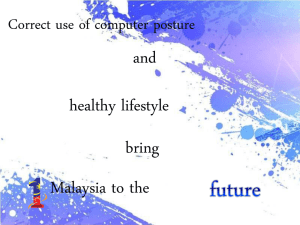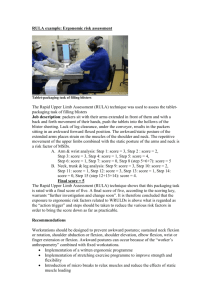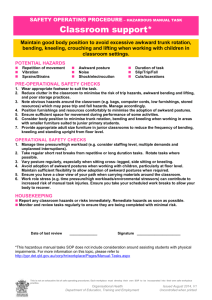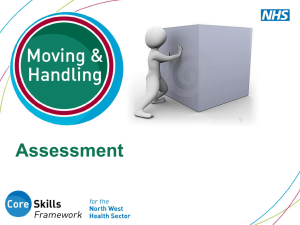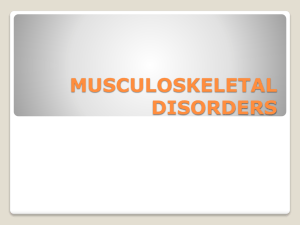ERGONOMICS Work Smarter, Not Harder
advertisement
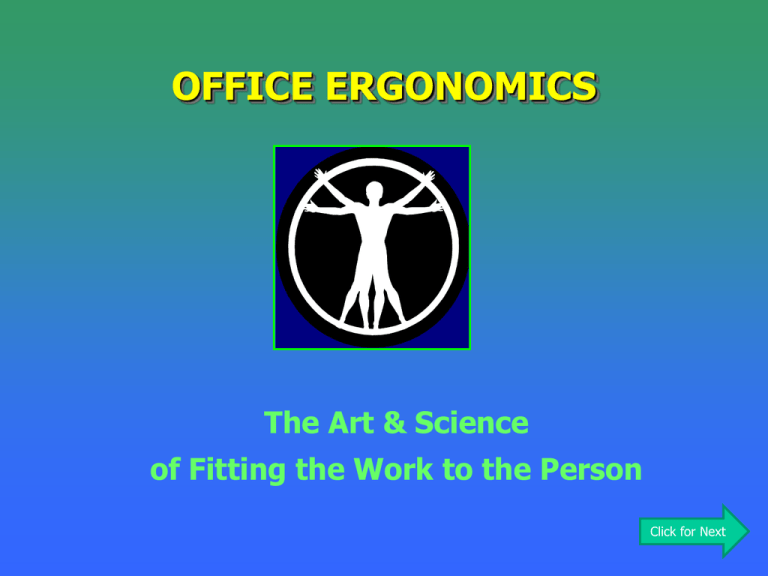
OFFICE ERGONOMICS The Art & Science of Fitting the Work to the Person Click for Next Why Ergonomics ? To Prevent disorders of the soft-tissues such as muscles, tendons, nerves, blood vessels, & joints. Common Office Environment Disorders: • • • • Carpal Tunnel Syndrome Tendonitis Back Strain/Sprain …and others Click for Next Ergonomic Assessment The following slides provide information intended to help you identify potential risk factors and to give you ideas to help improve the ergonomics of your work activities. Use the ergonomic assessment form provided on the website to guide your through assessing and improving your work activities. http://www.montana.edu/wellness/wellAwards.html Click for Next Symptoms • • • • • • Numbness Burning Pain/Aching Tingling Cramping Stiffness • • • • • Tightness Decreased range of motion Deformity Decreased grip strength Loss of function If you experience these symptoms, you may want to request additional ergonomic assistance. Next Key Risk Factors Awkward Postures Repetition + Force Next Risk Factors While each risk factor is significant; discomfort or injury is more likely to develop when two or more factors are combined And the risk exposure is sustained over time. Next Ergonomic Assessment Additional Benefits: • • • • • • Improve comfort Decrease fatigue Enhance job satisfaction Increase productivity Extend work life Protect enjoyment of many life activities Next Minimize Risk Factors Posture Repetition The Goal of an ergonomics self-assessment is to help you identify AND reduce, eliminate, or safely manage potential risk factors in your work environment. Force Time Next Minimize Awkward Postures Use “Neutral Posture” at the Computer & Other Equipment Next BASIC NEUTRAL Neutral posture: • Back supported by the chair back • Ears, Shoulders, Elbows, Hips vertically aligned • Elbows, hips, knees bent at near-right angles (90o – 105o) • Feet flat on the floor or footrest The basic neutral position most lab personnel should utilize a majority of the time they spend seated at the computer or other equipment. Next Back Relief Forward tilt posture: Raise the chair height a few inches and tilt the front downward slightly (8o - 10o) Opens hip angle allowing legs to support some weight. Not recommended if you have knee or foot problems. May be used occasionally throughout the day by most people; but is not recommended for long periods at a time. Next Lower Body Relief Reclining posture: Lean back 10o - 20o into the chair's backrest and put your feet out in front of you. Opens hip and knee angles to help relax back muscles and promotes blood circulation. Leaning back too far can result in an awkward neck posture. May be used occasionally throughout the day by most people; but not recommended for long periods at a time. Next Standing Neutral Standing posture: • Provides biggest change in posture • Good alternative to prolonged sitting • Can be fatiguing, have chair available • Prop one foot up on a low footrest to help occasionally shift your weight. May be used occasionally throughout the day by most people; but not recommended for long periods at a time. Next Minimize Awkward Body Position Adjust Your Chair • Adjust your chair to achieve a neutral position – keep trying, it is an ongoing process! • Fix (or have fixed) a malfunctioning chair • Use a lumbar cushion for additional support or if chair lacks adequate back support or seat is too deep • Pad armrests that are hard or that have square edges • Remove armrests if they contribute to awkward postures • Use a foot rest or keyboard platform to help achieve neutral position if necessary Next Minimize Awkward Body Position Ideal Chair Features 1. 5-Caster Base 2. Height adjustability 3. Seat depth adjustability – either seat slides, back moves fore/aft , or chair is available in numerous sizes 4. Rounded edge to the front of the seat 5. Backrest adjustability – up/down, angle, and flex 6. Armrests are padded and adjustable – up/down, in/out and/or removable Next Minimize Awkward Body Postures Locate monitor: • Directly in front of keyboard, no twisting neck or back to view screen • As far away as possible where material is still easily read. Arm’s length or more is desirable • Top of screen at or slightly below eye level; lower if wearing bi/tri-focal glasses • At right angle to overhead lights and windows Next Minimize Awkward Hand & Wrist Postures Awkward Neutral Neutral Awkward Awkward Neutral Neutral Awkward Next Minimize Awkward Hand & Wrist Postures When Using Input Devices (Keyboard, mouse, etc.) • Proximity – Items close enough to use while your elbows are aligned between shoulders and hips. No reaching from the shoulder. • Angle – Wrists & forearms parallel to the floor. No forearm or wrist angle. • Padding - No resting on hard edges. Gel wrist rests are helpful. Next Minimize Repetitive Motions Repetitive Motions are those that are repeated every few seconds for extended periods of time. Repetitive activities are most often a concern when combined with awkward positions, high forces, or significant amounts of time spent at the activity without adequate recovery time. Next Minimize Repetitive Motions Steps to reduce repetitive motion: • Utilize technology - programmable “hotkeys”, autocorrect, voice recognition, and other software features reduce repetitive keying/mousing. • Mechanize - Use electronic staplers, collators, and other tools for large, repetitive projects. • Vary tasks – Perform repetitive tasks in several small time blocks rather than all at once; perform dissimilar tasks in between. • Vary methods– Periodically switch process flow, switch tools, switch positions, switch hands to perform the same task. Next Minimize Repetitive Motions Additional steps to reduce risks from repetitive motion include alternatives to the standard keyboard and mouse, such as: • Trackballs • Vertical mouse • Natural or Ergonomic keyboards • Split keyboards • Rollermouse, Next Minimize High Forces Minimizing awkward postures reduces many of the forces placed on your body during computer use. Other steps to reduce forces: • Avoid resting your wrists against a desk edge • Do not over-fill file drawers • On large projects, consider mechanized alternatives to manual comb-binding, stapling or manual physical tasks that are also highly repetitive. • Follow safe lifting practices at all times. Next Safe Lifting Practices Bend your Knees Get Close to the Load - Not your Back! Use Large Leg Muscles to Rise Until Standing Next Laptop Computers Good ergonomic postures are difficult with a laptop Full-time users: • Use separate keyboard and mouse • Position screen for optimal viewing Occasional users: • Position laptop for neutral wrist position • Angle screen to minimize bending at the back & neck • Modify your position regularly, especially if feeling discomfort • Limit time spent on a laptop computer if you can’t relieve awkward postures Next Time – Frequency, Duration & Recovery Minimize key risk factors AND Balance time spent exposed to risks with adequate recovery time. Next Hints: 1. No “One Right Way” to achieve a neutral posture – experiment with adjusting different elements of your workstation to achieve neutral postures. 2. Adjusting one element of your workstation will affect other aspects. For example, lowering your chair height will change your elbow, wrist, hip and knee angles. 3. Healthy neutral positions can most often be achieved by adjusting existing furniture and equipment. Occasionally different items are helpful or necessary. Next Early Intervention is Critical E arly R esponse G ains O pportunity • • • • • • Reduce/Eliminate risks Prevent Pain Avoid or minimize need for medical treatment Happier employees Higher productivity Financial Savings by avoiding time away from work Next Conduct a Self-Assessment Use the ergonomic assessment form provided on the webpage to guide your through a self-assessment of your work activities. http://www.montana.edu/wellness/wellAwards.html Next Questions or Concerns? Consult additional resources on this website. Contact your Wellness Coordinator for additional assistance and resources http://www.montana.edu/wellness/wellAwards.html END

